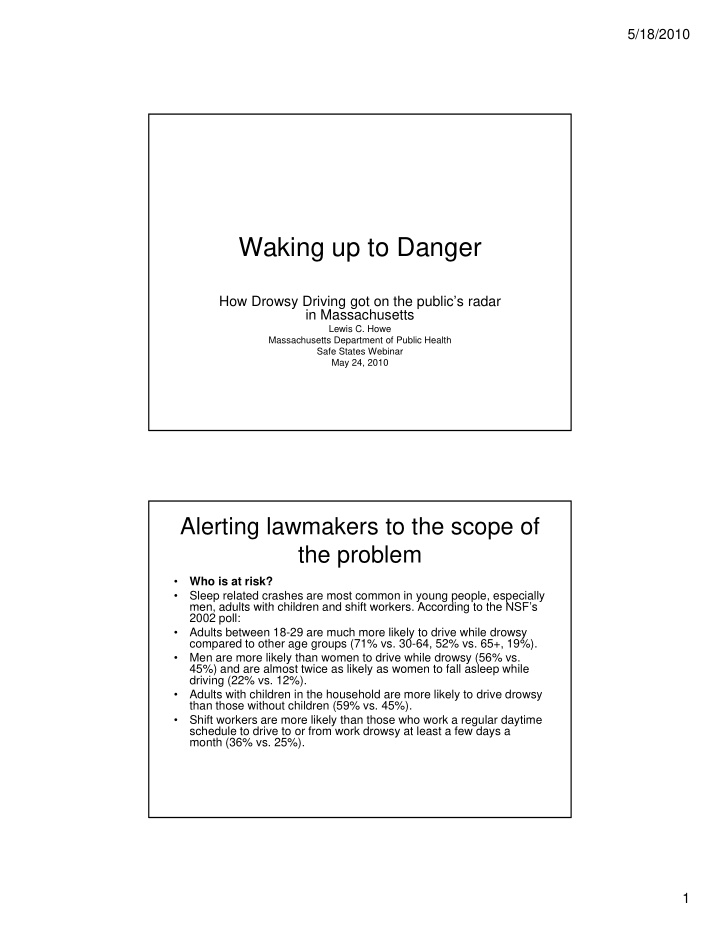



5/18/2010 Waking up to Danger How Drowsy Driving got on the public’s radar in Massachusetts Lewis C. Howe L i C H Massachusetts Department of Public Health Safe States Webinar May 24, 2010 Alerting lawmakers to the scope of the problem • Who is at risk? • Sleep related crashes are most common in young people, especially men, adults with children and shift workers. According to the NSF s men adults with children and shift workers According to the NSF’s 2002 poll: • Adults between 18-29 are much more likely to drive while drowsy compared to other age groups (71% vs. 30-64, 52% vs. 65+, 19%). • Men are more likely than women to drive while drowsy (56% vs. 45%) and are almost twice as likely as women to fall asleep while driving (22% vs. 12%). • Adults with children in the household are more likely to drive drowsy than those without children (59% vs. 45%). • Shift workers are more likely than those who work a regular daytime schedule to drive to or from work drowsy at least a few days a month (36% vs. 25%). 1
5/18/2010 As bad as OUI • Sleep deprivation increases the risk of a sleep-related crash; the less people sleep, the greater the risk. According to a study by the AAA Foundation for Traffic Safety people who sleep six to seven AAA Foundation for Traffic Safety, people who sleep six to seven hours a night are twice as likely to be involved in such a crash as those sleeping 8 hours or more, while people sleeping less than 5 hours increased their risk four to five times. • A study by researchers in Australia showed that being awake for 18 hours produced an impairment equal to a blood alcohol concentration (BAC) of .05, and .10 after 24 hours; .08 is considered legally drunk. • • Other research indicates commercial drivers and people with Other research indicates commercial drivers and people with undiagnosed sleep disorders such as sleep apnea and acute insomnia are also at greater risk for fall asleep crashes. Legislative Mandate to Action • Enabling section from JO law 2007 • Commission established to develop effective prevention education strategies. • Hearings held at MA State House led to release of report in March 2009. 2
5/18/2010 The Result: A living document • “Asleep at the Wheel” • Report of the Special Commission on Drowsy Report of the Special Commission on Drowsy Driving • Senator Richard T. Moore, Senate Chair • Joint Committee on Health Care Financing • Rachel Kaprielian, Registrar • Massachusetts Registry of Motor Vehicles • Mr. John Auerbach, Commissioner M J h A b h C i i • Massachusetts Department of Public Health • February 2009 Convening partners for earned and paid media • Harvard Sleep Research • Massachusetts General Hospital • Boston Medical Center • Teamsters Local #25 • Herb Chambers auto dealerships • Survivors of D.D. 3
5/18/2010 Prevention Messages • Before “hitting the road” • Get adequate sleep—most adults need 7-9 hours to maintain proper alertness during the day alertness during the day • Schedule proper breaks—about every 100 miles or 2 hours during long trips • Arrange for a travel companion—someone to talk with and share the driving • Avoid alcohol and sedating medications—check your labels or ask your doctor • Countermeasures to Prevent a Fall-Asleep Crash While Driving • • Stop driving Stop driving • Take a nap • Drink a caffeinated beverage. • Be aware of rumble strips. A word from our sponsors: Posters and handouts… 4
5/18/2010 …and a TV spot in heavy rotation 5
5/18/2010 Teamwork gets results Outcomes • MA Rumble Strip law • Distracted driving bill • “icrash” injury symposium, April 2010 • AAA to undertake Drowsy Driving task force summer 2010 6
5/18/2010 AAA makes Drowsy Driving Prevention a Priority • Stay Alert! Drowsy Driving Is Dangerous Driving • Here’s a startling statistic: it's estimated that as many as g y 250–thousand people doze off at the wheel every day – many for just a second or two, but that's long enough to cause a life-altering crash. • A significant percentage of us – especially teenagers – are sleep-deprived. AAA's message: drowsy driving is impaired driving–affecting focus, reaction time, judgment, and alertness. • Don't drive drowsy, and don't let your friends or children Don't drive drowsy and don't let your friends or children drive when they're tired. If you feel sleepy, pull over and rest, or call a friend or relative for help. View Drowsy Driving resources Resources • NHTSA • National Sleep Foundation • Dr. Czeisler and Dr. Sanna, Harvard 7
Recommend
More recommend